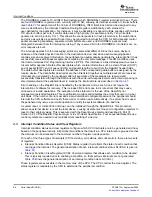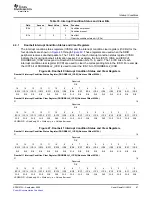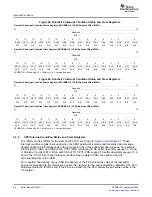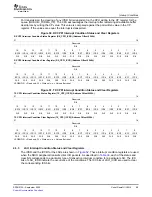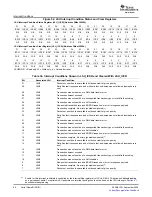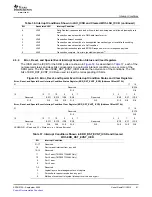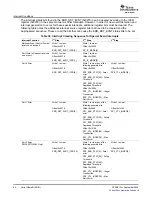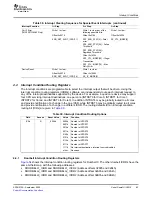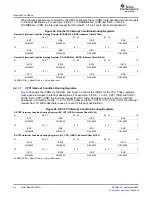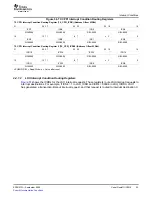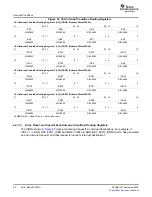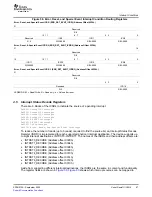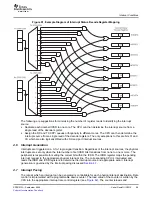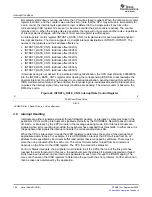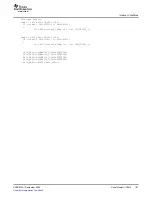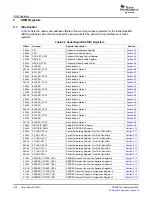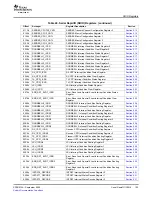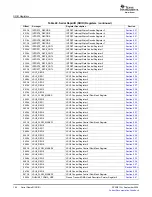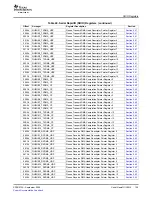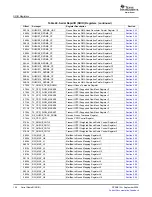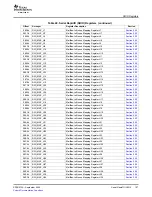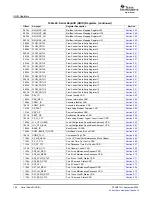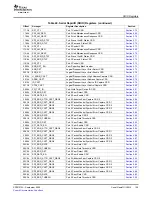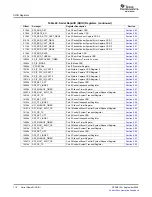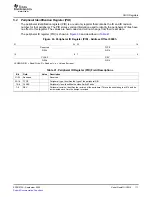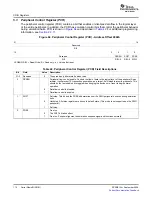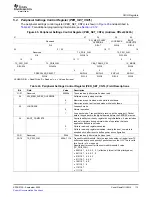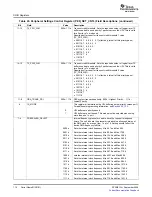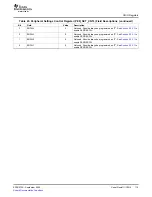
www.ti.com
4.8
Interrupt Handling
Interrupt Conditions
immediately starts down-counting each time the CPU writes these registers. When the rate control counter
register is written, and the counter value reaches zero (note that the CPU may write zero immediately for
a zero count), the interrupt pulse generation logic is allowed to fire a single pulse if any bits in the
corresponding ICSR register bits are set (or become set after the zero count is reached). The counter
remains at zero. When the single pulse is generated, the logic will not generate another pulse, regardless
of interrupt status changes, until the rate control counter register is written again.
An interrupt rate control register (INTDSTn_RATE_CNTL) is implemented for each supported physical
interrupt destination. The device supports up to eight interrupt destinations, INTDST0–INTDST7. The
names of the registers and their address offsets are:
•
INTDST0_RATE_CNTL (Address offset 0320h)
•
INTDST1_RATE_CNTL (Address offset 0324h)
•
INTDST2_RATE_CNTL (Address offset 0328h)
•
INTDST3_RATE_CNTL (Address offset 032Ch)
•
INTDST4_RATE_CNTL (Address offset 0330h)
•
INTDST5_RATE_CNTL (Address offset 0334h)
•
INTDST6_RATE_CNTL (Address offset 0338h)
•
INTDST7_RATE_CNTL (Address offset 033Ch)
If interrupt pacing is not desired for a particular interrupt destination, the CPU must still write 00000000h
into the INTDSTn_RATE_CNTL register after clearing the corresponding ICSR bits to acknowledge the
physical interrupt. If an ICSR is not mapped to an interrupt destination, pending interrupt bits within the
ICSR maintain current status. When enabled, the interrupt logic re-evaluates all pending interrupts and
re-pulses the interrupt signal if any interrupt conditions are pending. The down-counter is based on the
DMA clock cycle.
Figure 62. INTDSTn_RATE_CNTL Interrupt Rate Control Register
31
0
32-bit Count Down Value
R/W-0
LEGEND: R/W = Read/Write; -n = Value after reset
Interrupts are either signaled externally through RapidIO packets, or internally by state machines in the
peripheral. CPU servicing interrupts are signaled externally by the DOORBELL RapidIO packet in direct
I/O mode, or internally by the CPPI module in the message passing mode. Error Status interrupts are
signaled when error counting logic within the peripheral have reached their thresholds. In either case, it is
the peripheral that signals the interrupt and sets the corresponding status bits.
When the CPU is interrupted, it reads the ICSR registers to determine the source of the interrupt and
appropriate action to take. For example, if it is a DOORBELL interrupt, the CPU will read from an L2
address that is specified by its circular buffer read pointer that is managed by software. There may be
more than one circular buffer for each core. The correct circular buffer to read from and increment
depends on the bit set in the ICSR register. The CPU then clears the status bit.
For Error Status interrupts, the peripheral must indicate to all the CPUs that one of the link ports has
reached the error threshold. In this case, the peripheral sets the status bit indicating degraded or failed
limits have been reached, and an interrupt is generated to each core through the ICRR mapping. The
cores can then scan the ICSR registers to determine the port with the error problems. Further action can
then be taken as determined by the application.
100
Serial RapidIO (SRIO)
SPRUE13A – September 2006
Submit Documentation Feedback

